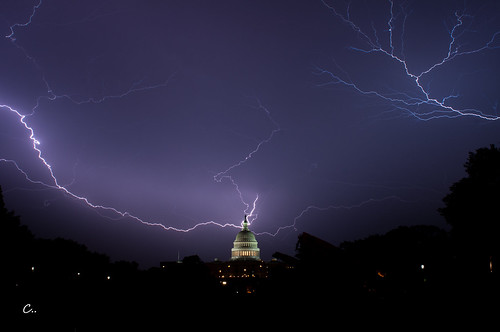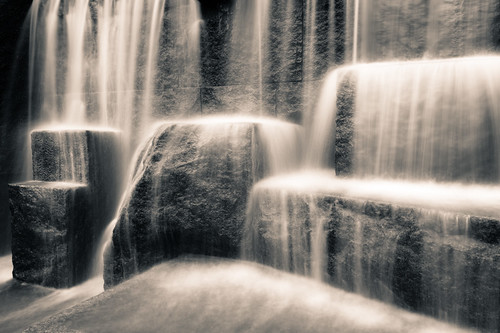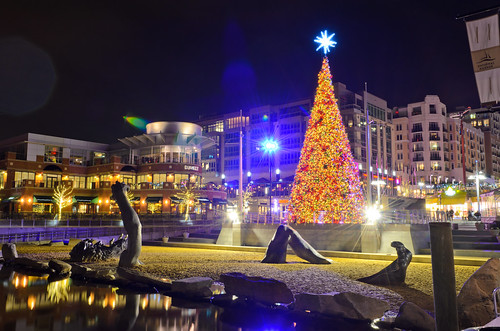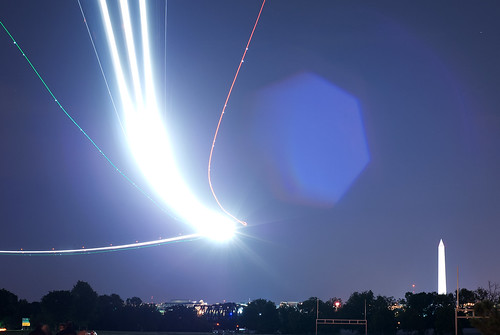There have been a lot, A LOT of cherry blossom photos posted over the past week. One could argue that every angle and vantage point around the Tidal Basin has been used and abused, that it’s hard to create a unique and unseen photograph of those fluffy little flowers. While that may be true to a certain extent I’d argue that that just makes it more of a challenge. It used to be that you could get down to the water by 8 am and still have the place (mostly) to yourself with a good hour or two until the tour buses and sandal-clad tourists started making the rounds. Now only the most dedicated, those who are willing to forgo those extra moments of shut eye just so they can have a moment with the trees without the distraction of fellow human beings, are the ones who get the photographs of the bloom in all it’s glory. Cathy Hammer got down to the Tidal Basin before sunrise on a Sunday to get this amazing shot. She set her f-stop at 13, set the shutter for 30 seconds and let it go. The result is stunning. The water seems to be frozen and the whole scene shows crisp detail. A scroll through her photostream offers some wonderful evening shots as well. It may be an angle we’ve seen before but certainly never quite like this. Great job, Cathy.
Tag Archives: long exposure
Featured Photo
Typically a photographer doesn’t take a long exposure during the day; this makes sense. A long exposure, which is when the shutter is left open for an extended period of time, rather than a fraction of a second, will let in more light. The day time being when the sun is out, that means you would typically have a worthless, blown out exposure. That is, unless you had a little piece of equipment called a neutral density (or ND) filter, which reduces the intensity of the light entering the camera. These little pieces of glass can open a whole new world of photography to those who want to try it.
And if you do try it, you can get stunning pictures like Kevin got above. This thirty second exposure of the Air Force Memorial, during the middle of the day, while using an ND filter, looks like something from a dream. There are multiple features of this photo worth pointing out: the motion blur of the clouds; the fascinating play of light on the metal arms of the sculpture; and, of course, the color of the sky. Kevin says that the color is not from post processing and is simply how the light interacted with the filter glass. Truly an excellent photo; makes me want to go buy one of those filters and start playing!
Featured Photo
Long exposures, where the shutter of the camera is left open for longer than the fraction of a second of a normal photograph, are normally a night photographic technique. Which makes sense; exposing a sensor or film frame to such a large amount of daylight normally results in a worthless picture. But there are ways to make it work, as Chris shows above. While I’m unsure if his shot is achieved through post-processing in a computer program or an in-camera technique, it is a good example of a daytime long exposure.
Chris’s photo creates a great sense of movement, while simultaneously giving an idea of the crowd of people. As well, framing the shot between two cherry tress skillfully contains the subject matter. Lastly, the most powerful part of the shot is the solitary, and unmoving, bench in the middle of the frame. Juxtaposed against the ghost like movement of the people, one is left with a sense of time; both those things that are transitory and those that are stationary. It is a shame that there aren’t any cherry blossoms to add more color to the shot (new peak prediction is April 6-10) but it is a small issue. All around an excellent shot for the season!
Featured Photo
With each passing day the scaffolding around the Washington Monument moves higher and higher. If you will recall, the world’s biggest obelisk is getting the treatment to fix a number of cracks that occurred during (or were found after) the 2011 Earthquake. Even though we’ve lost being able to go into the monument until some time next year, the small benefit is that we get to see it wrapped up in the scaffolding again (look here for an idea on what it will look like completed).
Kim’s picture does a great job of capturing this time in the life of the monument. First, we have the crisscrossing lines of the scaffolding to draw the eye. Then the black of the night sky and the metal scaffolding, combined with the brighter white of the illuminated monument, create a great contrast. The flags provides a nice splash of color to the whole photo; as well as providing an interesting tell that this is a long exposure shot. All around, an excellent shot.
Featured Photo

Untitled
courtesy of Noe Todorovich
A short time ago, in a art gallery not far away. Ok, how about this one: the art must flow! Not good enough? Would you like to know more? Then we’ll have to go straight to…ludicrous speed!
Ok, enough with my lame, joke sci-fi references. Noe does a great job capturing Leo Villareal’s Multiverse at the National Gallery. This light sculpture is a favorite of photographers, because you never take the same photo twice. But Noe goes a couple of steps further. First by actually moving the camera to create a fascinating whirlpool effect. She also used her iPhone to get the shot, which is very impressive considering this hallway can be especially dark when only a few of the LED lights are on. All around a unique and excellent photo.
Featured Photo

Unexpected Thunderstorm
courtesy of Can Wong
I know we don’t want to keep talking about Friday’s storm, but you’ll have to forgive me with this picture. I mean look at it; isn’t it just amazing? From the ominous blue color of the sky, to the lightning streaks, to the framing of the Capitol Dome; this is damn near perfect. Can Wong must have risked life and limb to get this shot, but it certainly paid off. I tip my cap to you, sir!
Before I got into photography, I always wondered how people caught shots like this. As it turns out, this is equal parts skill and luck. The actual technique is a long exposure; keeping the camera lens open for longer than a fraction of a second of a normal photograph. That way the lightning, which only last a second or two, can snake across the sky and be caught by the camera. The luck comes in with where you point the camera, and whether you have the camera exposing when the lightning strikes. Because as soon as you see the lightning, it’s already to late to get a photo. Sounds simple, but it’s not. That’s why I’m in awe of this one!
BTW: last reminder about the 4th of July Fireworks meetup tomorrow. 6:30pm meet up near the Arlington Cemetery metro stop; read the post for more info.
Featured Photo

FDR Room Four
courtesy of theqspeaks
One of the benefits of doing a long exposure is that you are able to capture motion in a still photograph. Think about that for a moment; it sounds like an oxymoron, doesn’t? But then you have pictures like the one above from theqspeaks, which is of one of the more dramatic fountains in the FDR Memorial along the Tidal Basin. The water is both frozen and moving within this two second exposure, giving a new perspective on the fountain, splashes and all. As well, the blacks of the rocks contrast well against the white of the water. All around an excellent photo!
Featured Photo

Woodrow Wilson bridge
courtesy of vpickering
With the reflective surface of the Potomac, Victoria was able to get the colors of the Wilson Bridge’s lights in the river. And since it’s a long exposure, the movement of the Potomac gives the reflection a fascinating blurred look which draws the eye upward to the structure; all those vertical lines in the water point to the horizontal line of the bridge. Truly a fascinating shot, of a relatively simple form.
Featured Photo

Going Home
courtesy of Paul Frederiksen
A good long exposure makes for a great picture. And if you take the shot in the right light, it can become magical. Take Paul’s long exposure of traffic along the George Washington Parkway. We see traffic coming and going; the white of the oncoming lights and the red of the receding ones. But in addition to the artificial light, there’s the wonderful purple and oranges of the evening sky. Such a mixed lighting situation can be difficult to capture in a photo, because the lights of the traffic are not as bright as the light of the sky. But Paul used a neutral density filter, which reduced the overall light of the scene and allowed him to keep the lens open longer. Thus those near perfect lines of traffic and a gorgeous sky. Well done!
Featured Photo

‘National Harbor 2011.11.26 3.jpg’
courtesy of ‘JasonianPhotography’
A long exposure can make for an excellent photo. By keeping the shutter open for a few seconds, a photographer is able to pick up a wider range of lighting than in a fraction of a second shot. It can also give some great lighting effects, like the starbursts from the very bright street lights and spotlights. JasonianPhotography certainly shows us what kind of lighting is around National Harbor and the Awakening statue, does it to great effect.
And, of course, the photo helps us get into the Christmas spirit!
Featured Photo

‘Circling Around’
courtesy of ‘Eric Spiegel’
Long exposures, or keeping the shutter open for longer than the fraction of a second in a typical photograph, can do amazing things in photography. Sometimes you know what you’re going to get in the shot; a lot of the time, you get wonderful surprises. The technique can be used to show motion; it can be used to bring out bright colors; it can show fine details; it can do awesome things with reflections; and sometimes it captures that which is both quick and beautiful.
Eric shows off many of the best aspects of long exposures with this shot of a plane’s approach into DCA. Colors of the plane’s running lights are bright and distinct; the surprise hextagon lens flare which adds a bit of mystery to the shot; and the wonderful lines of the plane’s approach catch the eye. It all comes together for an excellent long exposure.
Featured Photo
Fluidity by primplan
With so many awesome photos in our pool lately, it was hard to decide on just one to write about (in fact it always is). In the end, the creative use of a two second exposure to capture the movement of this belly dancer at Marrakesh won me over. Sometimes it’s difficult to “think outside of the bun” when you’re shooting, and other times you can be pleasantly surprised by a mistake. While this would have been a cool shot had the dancer’s movements been frozen, she’s given a whole other dimension by the blur of her upper extremities.
Not to beat a dead horse here people, but time is running out for our Holiday Photo Contest! Tag your photos with “WLDC holiday 2008″ and drop it into our Flickr pool by January 1st. It’s 100% free to enter and you could be the lucky winner of some great prizes!
